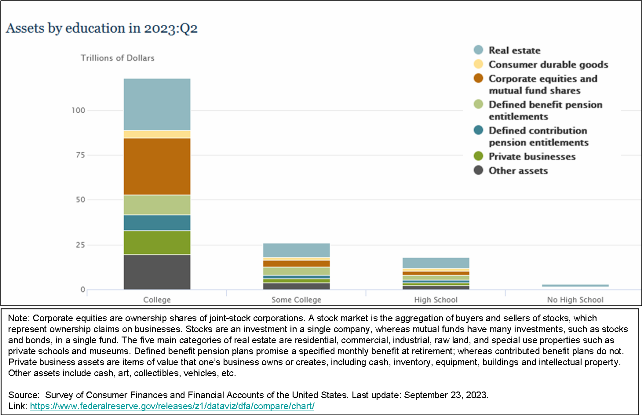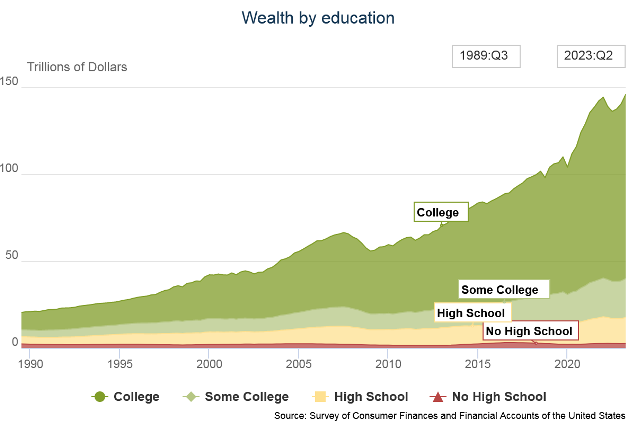The Federal Reserve provides information on the distribution of U.S. household wealth in the form of interactive charts and tables. These allow users to explore household wealth components, shares and levels across various groups and time. The information was last updated in September 2023. This post will cover wealth assets and trends by education level. Here’s the chart of assets by education level:
A very brief explanation of terms: the five main categories of real estate are residential, commercial, industrial, raw land, and special use properties such as private schools and museums. Corporate equities are ownership shares of joint-stock corporations. A stock market is the aggregation of buyers and sellers of stocks, which represent ownership claims on businesses. Stocks are an investment in a single company, whereas mutual funds have many investments, such as stocks and bonds, in a single fund. Defined benefit pension plans promise a specified monthly benefit at retirement, whereas contributed benefit plans do not. Private business assets are items of value that one’s business owns or creates, including cash, inventory, equipment, buildings and intellectual property. Other assets include cash, art, collectibles, vehicles, etc.
Per the US Census Bureau, here are the highest levels of education achieved by Americans in 2022: 37% have a bachelor’s degree or higher, 25% some college or an associates degree, 28% high school diploma, and 9% less than a high school diploma or its equivalent. And per the Federal Reserve, Americans with college degrees or higher own 71% of the country’s wealth, with another 16% belonging to those with some college, 11% to high school graduates (or the equivalent) with no additional education, and a measly 2% to individuals who did not complete high school. In other words, if you want to accumulate wealth these days, an almost-necessary (but not sufficient) condition is some kind of continuing education and training past high school. This has pretty much been the case over the past 30 years although there was a lot less wealth to go around in the olden days of the 1990s. Check the chart:
Unfortunately, a good portion of American adults lack the literacy and math skills to thrive in “higher education”, whether we’re talking trade school or law school. Ditto for thriving in well-paying jobs, which are pretty much a prerequisite for the accumulation of wealth. As to how to go about improving literacy and math skills in the general populace, here are some ideas from a previous post. To quote:
“…reduce chronic stressors that interfere with children’s cognitive development (e.g., neighborhood violence, homelessness), improve K-12 schools, increase access to childcare, preschool, healthcare, and nutrition assistance; insure that cheap adult education and training programs are readily available, and provide an Adult Student Basic Income for qualified US residents, whether they’re in grad school or taking remedial English and math classes.” Accounting for Inequality: Literacy, Math Skills, and Wages, Exploring the Problem Space

